Why Startups Should Start with SEO from Day 1 [Case Study part I]
“to take a paper plane and turn it into a rocket is an art.”
Prelude:
The case study below was first written and pitched to Ahrefs in February 2018. However, this case study never saw light as the Head of Content @ Ahrefs rejected it. Although the idea was accepted, the head of content couldn’t agree on some of the strategies we used to grow our startup’s blog.
And it’s fair enough.
At the end of the day, we are not an SEO agency. We are a startup. And what marketers in startups have to do is to take a cent and try to turn it into a hundred dollar bill.
Anyway.
I have never published this case study ever since the pitch. Probably I felt a little bit discouraged.
However, after listening to Tim Soulo interview on Indie Hackers (which I encourage you to listen to), he said something like (I can’t remember the exact words) “Startups should start doing SEO from day 1.”
And this is true. The time will pass anyway so why waiting 6 months or a year before starting with your SEO strategy. And what a better way to support this statement, than showing a real case study on this topic.
So, the case study below is precisely the same one, I pitched in 2018. I will make a follow-up case study — Part II, explaining what the results have been after a year. I will elaborate a bit on the SEO mistakes I’ve made and the obstacles we have faced.
Okay, I hope you enjoy this part of the case study and stay pumped for the upcoming part II.
________
How I Used Agile Marketing Principles to Increase Flow-e Organic Traffic by 889% in 2 Months [Case Study Part I]
I bet that you have heard the agile mantra in software development “ship early, ship often.” The agile marketing equivalent is similar, especially when you are trying to grow a startup as fast as possible, so you don’t burn all of your money.
Moreover, this is precisely what “ship early, ship often” means — to take advantage of testing, data, and numerous small experiments, it is necessary to ship your marketing concepts quickly and launch your marketing campaign as early as possible. Then, based on feedback, you can improve your campaigns and launch again.
Being agile — adaptive, transparent, and iterative are necessary skills when we live in a world where Google lead this dance.
You should understand that, while today, I can probably think of at least 11 ways to conduct a marketing strategy, in a startup environment there is only one way — the quickest and the most productive marketing strategy will work.
And in this case study, I’ll show you my exact approach to increasing Flow-e organic traffic steadily, while applying agile marketing principles so I can:
- Get more things done;
- Get the right things done;
- Adapt to the never-ending marketing changes.
How to read this case study:
Even if you are not building a startup, but for example, an affiliate niche website or just a side project, you can still apply this approach.
If you are just starting, then you can replicate the whole process entirely and see how my approach performs in your industry.
If you have already started the process but your results are mediocre, and you believe that there is a space for improvement, I will advise you to compare and contrast both approaches to find patterns and gaps. Then fill the gaps and take advantage of the patterns by executing more of what could lead to quick, but steady results.
Now let’s cut straight to the chase.
1) Set up a proper blog structure that speaks SEO
There are two types of crawlers we try to impress — search engine crawlers and your customers’ eyes. And very often when I analyze competitors and other startup websites, there is the following pattern — they neglect the optimization of the blog page structure for both, crawlers and customers.
Categories help search engines to understand what your blog and website are about. Categories are also a great way to navigate your customers once they visit your blog.
I don’t know if it is the chicken or the egg first, but I know in SEO the backbone of the blog comes before hitting the publish button.
The first thing I did is to generate ideas with Ahrefs Keywords Explorer Tool and choose the main keywords for the categories. I searched for the most proper and user-friendly keywords that will best describe what our startup product is about.
Here is a breakdown of the process:
- Open Ahrefs Keyword Explorer Tool
Write down a keyword relevant to your startup/product and choose your target country.
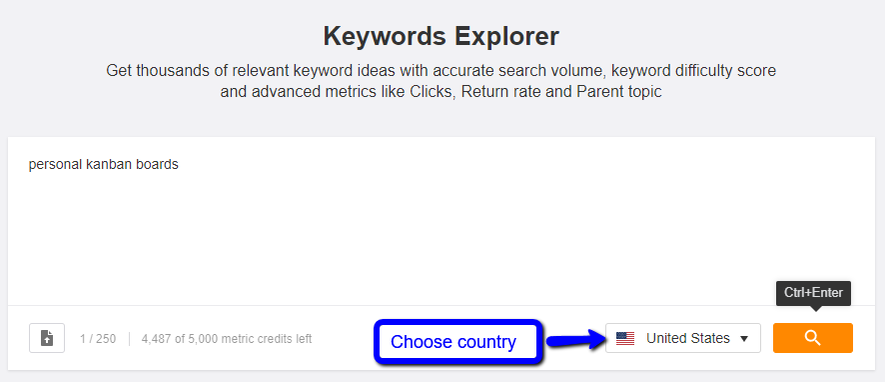
Now you have the result page, and you will see a field which says “parent topic.” Usually, I will choose the parent topic as one of my main categories.
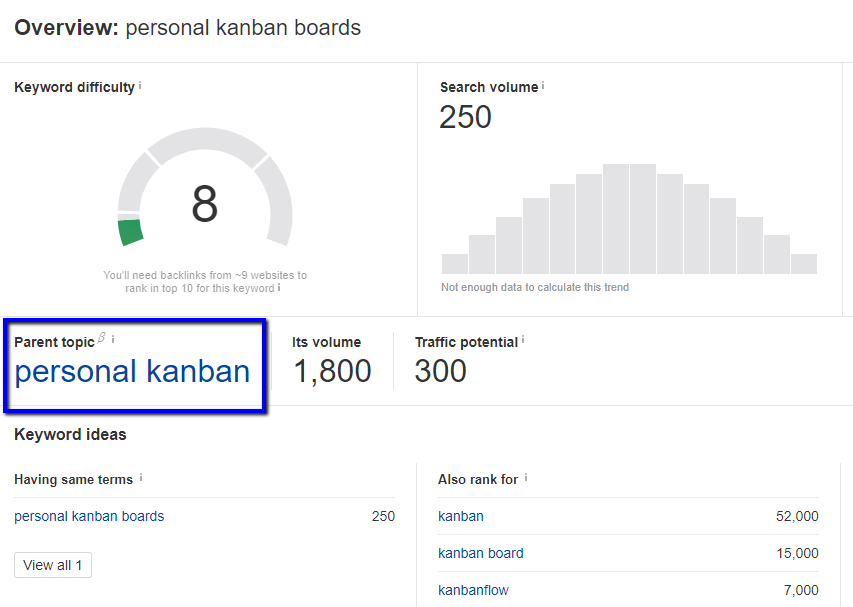
In this case, “personal Kanban” is the parent topic of “personal Kanban boards,” and this keyword is highly relevant, is not lengthy, and has a decent traffic potential.
I am looking for decent traffic potential in cases when a topic turns into a good candidate for a silo structure (refer to part #4). If it does, I will create a cornerstone page for that category (this could be quickly set up with a redirect).
And I will repeat this process multiple times until I find highly relevant “parent topics” and set them up as the main categories of our blog.
Here is an actual breakdown of our blog structure:
- Example 1: flow-e.com/blog/personal-kanban/blog-post-link
- Example 2: flow-e.com/blog/personal-kanban/outlook/blog-post-link/
I’ve chosen to test two types of category depth. I’ve put these two structures for two primary purposes:
- The first one is experimental. I would like to test which structure will favor search engines
- The second one is in case we decide to push our content in more broader topics such as Outlook and Google (we are currently focused only on Google/Outlook topics around email productivity methods).
An example here would be:
- flow-e.com/blog/outlook/blog-post-link/
This will ensure that we already have a warm place in Google regarding Outlook/Gmail related topics and we can actually test whether or not search engines perceive our product as a productivity tool for Outlook (to name an example).
What are the results so far from this category structure experiment?
Let’s compare the data from two blog post representing each of the structure above using the Ahrefs Site Explorer tool.
The two blog posts have the following characteristics:
- were published on the same date;
- were written by the same author;
- have the same length of approximately 1000 words each;
- have the same number of pictures;
- have roughly the same number of referring domains;
- are both equally on page optimized (the SEO plugin illuminates green).
Example URL 1: flow-e.com/blog/personal-kanban/blog-post-link

Example URL 2: flow-e.com/blog/personal-kanban/outlook/blog-post-link/

Let’s encrypt the data. Example URL 2 ranks for three times more keywords than Example URL 1.
Example URL 2 however, has two more referring domains (which is not a significant difference).
Both UR ratings are pretty close which shows me that the backlink profile of the target URLs is similar.
Example URL 2 ranks for three keywords on Google’s 1st page with a total volume of 40 searches/month. Example URL 1 ranks for two keywords on Google’s 1st page with a total volume of 260 searches/month.
It’s a high bet to conclude from 2 URLs which structure is better, but the conversion rate of Example URL 2 is slightly higher even though the total volume of searches/month is only 40 in comparison to 260 for Example URL 1.
Maybe I am over optimizing this process, but thoroughly analyzing this niche, the pattern is to go up to three steps deeper when it comes to categories.
Sure, most of the websites are big, but we are striving for greatness, and I don’t want 301 to be our next strategy.
My prediction is that Example URL 2 is about rank for much more keywords, as a significant portion of these keywords is currently low hanging fruits.
2) Chasing low volume keywords
Part of this approach I have stolen from this Case study How Low-Volume Keyword Strategy Can Get You High-Value Clients.
The question is: How low you can go?
The answer: Experiment.
Initially, everything you do in a startup is based on experiments and testing. And this process is no different.
For this part, I will assume that you know or you have an idea who your customers might be. And you are familiar with their business-focus. The keywords with business-focus are the one to seek.
Here is how you can determine the right low volume keywords:
- Open Ahrefs Keywords explorer tool;
- Plug one of the categories keyword you have already chosen.
I am using the categories keywords because I want my articles in silos (thus I want keywords related to the parent category). If you are not planning to build silos, you can plug any broader keyword related to your business.

- Select KW difficulty score < 10;
- Look for keywords with business-focus/buyer intention;
- Look for keywords that have none, or they have the following SERP features — featured snippets, related questions, or video.
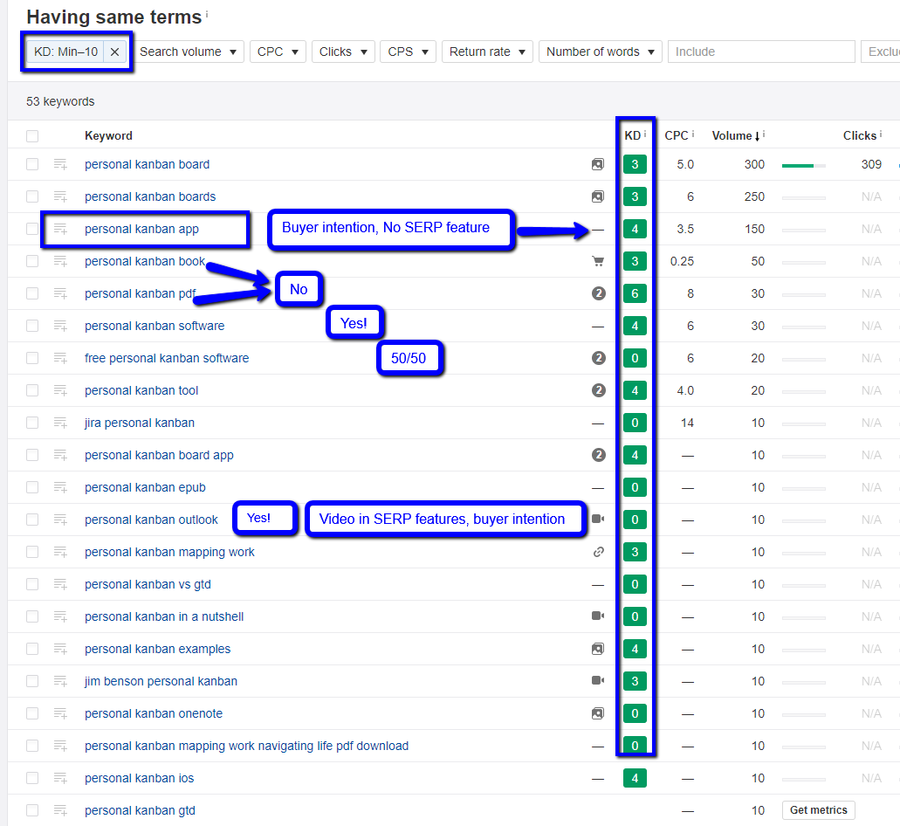
- Choose 3 to 5 KWs from each topic/category for which you are seeding keywords. Later I will put the articles in silos (you will read about silos below). I like creating silos the backward way.
Why I chase keywords with these characteristics?
For me, the easiest way (but I am not saying that it is easy) to bring some organic traffic from the beginning is to pick up the low volume, low KD keywords that usually get traction even without building links to them.
Of course, I don’t want to rank for generic low volume, low KD keywords, I want to chase the one that will convert into customers.
Like this one here:

This data report is for the period Dec 2017 — Jan 2018 and goal completions mean a sign up for our product.
So for these two months, an URL that targets a keyword with less than 10 searches/month, brought us, 57 users.
Now imagine if you can reproduce this process for 100 articles and they have close results.
I don’t know about you, but this thought feeds my curiosity even more!
Here are the results from our organic search growth
I have published 8 articles (1000 words each) in November 2017 and 8 more in December 2017.
The data below is a comparison between the organic search traffic for Nov 2017, Dec 2017, and Jan 2018.
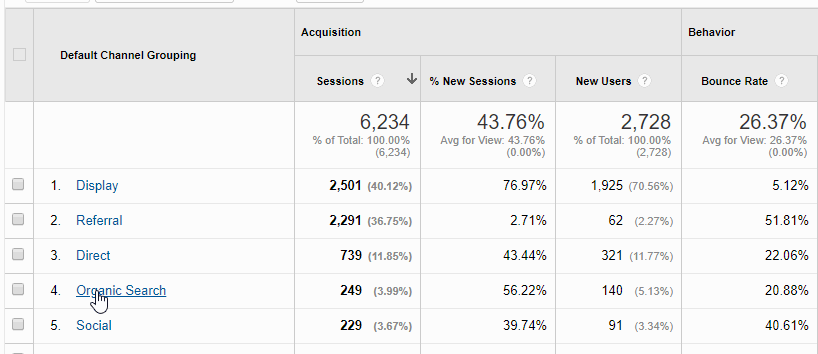
- Organic traffic for Nov 2017–249 sessions;
- Organic traffic for Dec 2017–1,007 sessions;
- Organic traffic for Jan 2018–2,214 sessions.
This data set shows that Flow-e organic search traffic has grown by 889% since Nov 2017.
And basically, this was achieved by targeting 16 low volume, but high converting keywords, important for our business.
3) Link building: Replicate your competitors’ first
But link building is so hard. Yes, it is. However, don’t forget that Elon Musk is not the first to build rockets. Someone else has done it before. Now, he is just taking advantage of and replicating the process.
This is exactly what you should do. You could even make it better and faster because you already have a pattern that works.
- Open Ahrefs and go to the Link Intersect tool;

- Put your 2–3 main competitors in “Show me who is linking to” and your domain in “But doesn’t link to” (this is optional, but I prefer to use it to avoid hunting links which my domain already has).
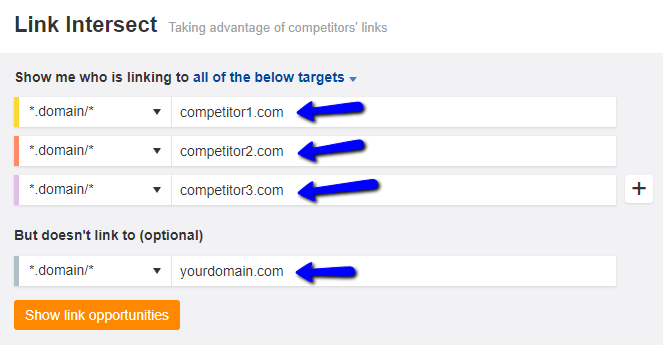
Once you hit “Show link opportunities” you will get a page with the results.
Usually, I look for patterns. I will chase the easiest links, first. These are:
- Directories (startup-related in our case);
- Profile forum links (forums, related to your niche);
- Community forum discussions (contribute to a niche-related discussion);
- Social bookmarking sites (Scoop.it, Stumbleupon).
You can get a link back from Scoop.it quickly. Sign up, create a topic and, submit your blog posts for curation.
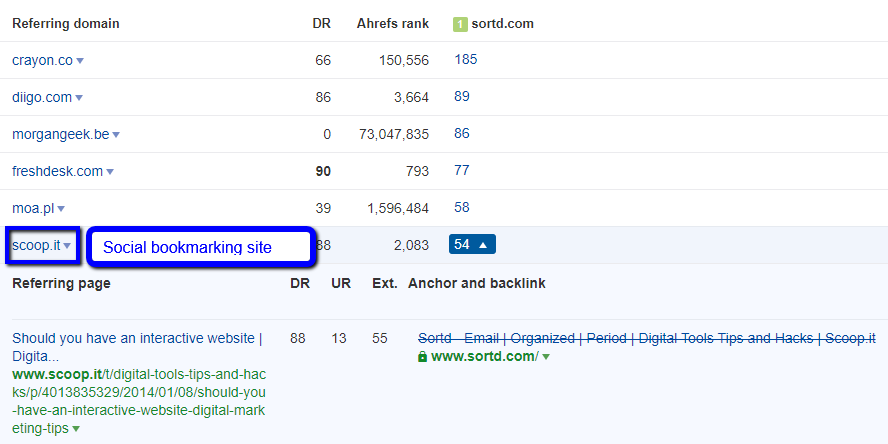
- Comments (on related niche blogs);
- Syndication (Medium);
- Social media links (where applicable).
Then I will proceed with the hardest one:
- PR publications (I would usually skip this one unless I have a very good product pitch);
Pitching an idea to any magazine is tricky. Naturally, they will feature products with a buzz around them. You can submit a tip, approach the authors, or you can use an Outreach/PR agency that has already built relationships with some authors.

I have run an experiment by creating an Initiative to see for a period of 2 weeks how many big online magazines I can approach, pitch, and be featured on (in agile marketing we do small experiments in short sprints. We don’t like doing long cardio).
The final result was — featured in 1 magazine. If I have to be honest — I won’t do it again. The conversion rate between effort and result was far from passable.
- Guest post contributions;
- Interviews (startup-related in our case).
Let me note that it is entirely OK to have diverse links — do follow/no follow from different sources. Receiving links from forums or directories is not a spammy tactic.
Just be relevant. Contribute — share valuable content with data and insights, give bits of advice, and help your community.
One advice here, in case you decide to build silos:
Start your link building strategy once you have enough articles ready for building two silos. Why? Because we will build links to them and then see which silo performs better. Make sure that you prepare your articles in two different categories.
This will allow you to run an experiment and see which topic Google (or another search engine) favors. And then guess what? You will write more articles for the winning silo.
Here are our results using the approach above
Here are our results from one link building campaign I performed at the end of last year.
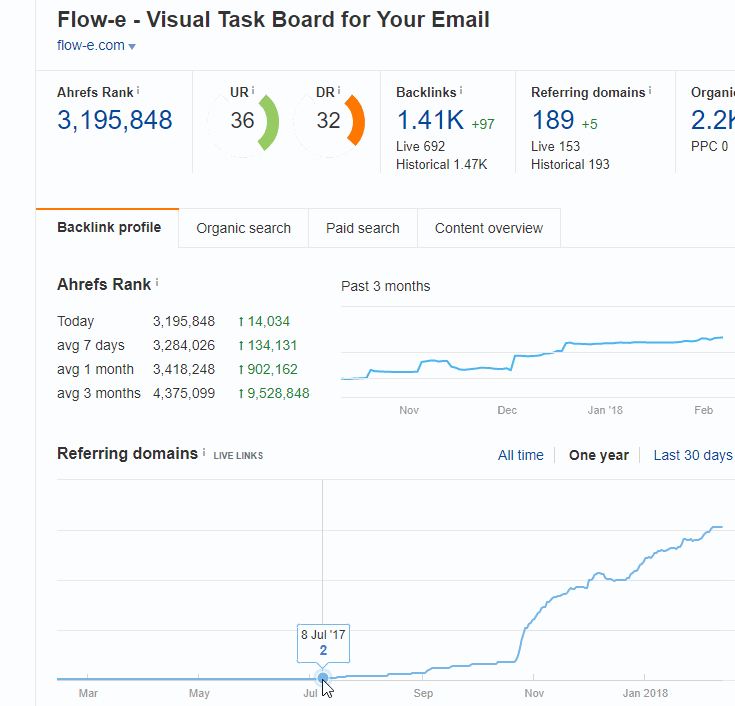
So on 1st July, Flow-e had 1 referring domain. On October 18th we have launched on Product Hunt, and we received natural traction of referring domains. Then, I have executed 2 link building campaigns, each conducted in a short one week sprints (separated by a month).
According to Ahrefs database, currently, we have 189 referring domains. Not bad.
One tip here:
I suggest that you perform many small link building experiments instead of “big bang” campaigns. Thus, you can quickly measure each approach and see which one worked best for your business.
Then you can improve and replicate the process so you can get more links done.
4) When Google shows love — take advantage of this moment
This is the moment we all seek. The growth of organic traffic. If you start ranking for positions between 11 and 20 (or even better in the top 10), then you should definitely push those pages forward.
Here is what you can do to capture this moment:
Publish the silos in reverse
Silo page is the main page of your silo that links “down” to the sub-articles below it. The theory behind is that with the power of the silo structure, you can beat high authority sites with fewer links.
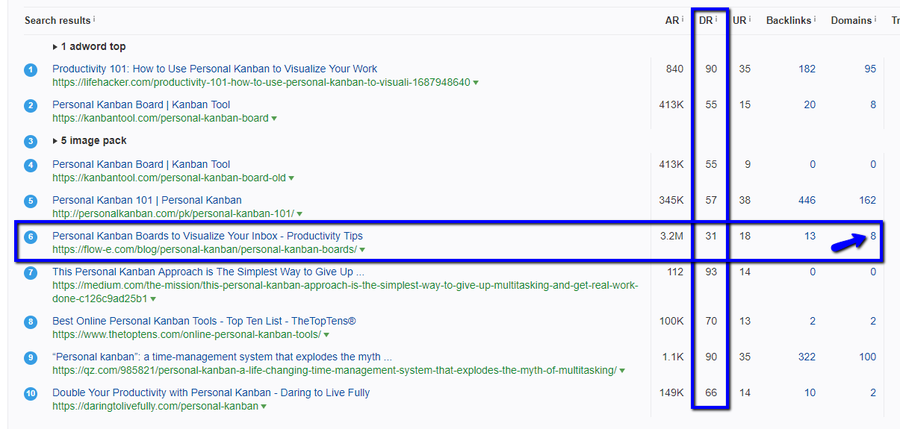
Most people create their silos by starting with the main cornerstone blog post.
Then they create short sub-articles (1000–1200 words each) covering different aspects of the cornerstone article and link out to them from the cornerstone post.
As I mentioned in chapter 1, I publish the silos in reverse. I will first create the sub-articles in two categories and see which one will start to rank faster.
I will write the cornerstone article after that. The point is that the cornerstone article should be an in-depth and a well-written overview of the main topic that links out to the more detailed sub-articles in that silo.
Here is one example:
I want to create a silo about one productivity method — Getting Things Done (GTD).
The first thing I did is to create the sub-articles:
- GTD for Outlook;
- GTD for Gmail;
- GTD Flowchart;
- Best GTD application.
Then I will wait for a month and see the ranking results. If we rank between 0–15 in the SERP results, then I will compile the cornerstone article.
In this example, the cornerstone article is an in-depth overview of the main topic which is GTD. I will link to the sub-articles and, I will link from the sub-articles to the cornerstone and between the sub-articles too.
I prefer to use the Isolation approach to silos — the posts in a given silo only interacts with other posts from that silo.
The siloing theory comes from:
- SEO Siloing: Building a Themed Website by Bruce Clay
- How To Silo Your Website series by Michael Gray
And I highly suggest that you read both articles and weight the pros and cons of this process for your business.
p.s the guides may have some outdated info regarding the Google algorithms because they were written some years ago.
Use Ahrefs Site Explorer
Put your post link in Ahrefs site explorer and take a look at all the KWs you are ranking but they are not present in your current blog post.

What I like to do is analyze the top 10 articles for most of the keywords and see the gaps in my content.
I will write new paragraphs, and I will include these keywords in the title and the body of the new paragraph. This doesn’t mean that you should do keyword stuffing. The purpose here is to fill the gaps and improve your content.
Repeat this process for each post from the silo you want to optimize.
Use Google Search Console (GSC)
3) I use GSC to determine which keywords have the highest CTR and then I’ll update the post accordingly. Sometimes placing two words differently in a key phrase makes a difference.
See below:

39,69% CTR for “outlook kanban” and 28,89% for “kanban outlook.”
Achieving 10% optimization in CTR is encouraging.
Update meta title, meta description, and H1 title
If you see a pattern in the SERP results to show, for example, that all the top results have their primary keyword at the beginning of the title/description, I would usually do the same.
However, I can’t confirm whether this correlates directly with ranking in this case. I’ve never previously experimented with this tactic isolated.
Fight for SERP features
Once my blog posts hit the first page, I will fight for the SERP features available. Why once I hit the first page? Because you have to rank on the first page for the given keyword to be eligible to acquire the so-called zero spot.
What should you do?
With Ahrefs you can check each keyword SERP features and what kind of features are available.

In this case, I can try to rank for inclusion in image pack and video features.
I don’t use plugins for this purpose. I’ve tested many plugins with some of my side projects and what best works is writing down a JSON code.
This is super easy because you can take the pre-made code from here and then change the data for your blog post.
I will guide you fast through this step.
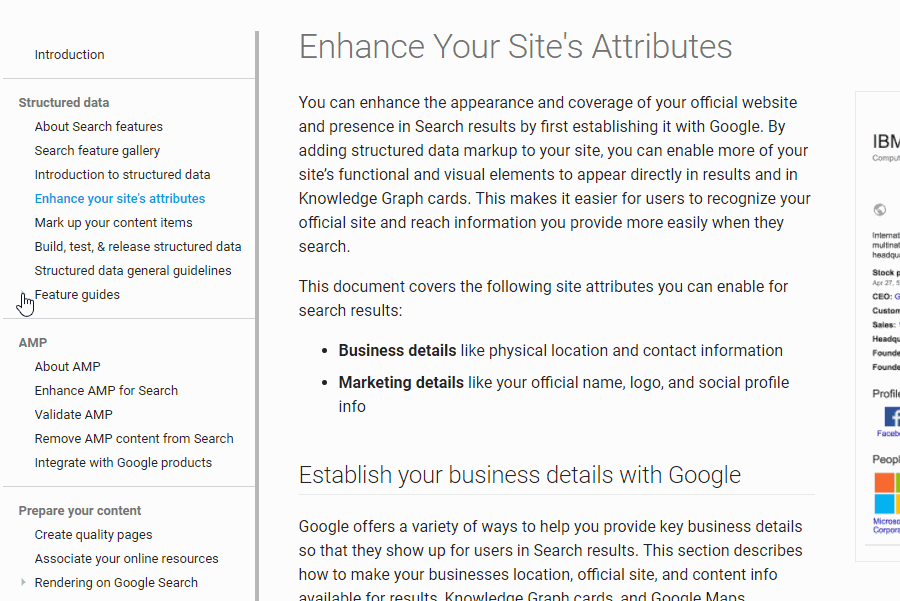
After you change the info in the code, you need to copy and paste it as close to the opening <head> tag as possible into the blog post/article (not the entire website).
You can have multiple SERP features on a single page so optimize it for the relevant features.
I will also suggest reading this research on SERP features: Are Google’s SERP Features Stealing Traffic from Your Site?
Final step
After I finish with the updates outlined above, I usually submit all of the links from the silo in GSC for indexing. I do this for good luck 😊
Seriously, I want Google to re-crawl the newly updated pages ASAP and to see if there will be any position changes.
5) Use the Ahrefs site audit tool to detect SEO issues
Ahrefs Site Audit tool is the Taj Mahal of the site audit tools. Recently updated, nice and clean (I love the new colors by the way), the tool shows the health of your website.
This is your VA that reminds you when issues are detected. And even better — shows you what you should do to resolve them.
First, add your website from the “+ New project” button.

Let’s see the overview of Flow-e website and the type of errors Ahrefs detects.

You can filter the errors you get by importance:
- Warnings;
- Errors;
- Notices.
Apparently, the first two need your attention first. Also, you can click on an issue which will lead you to a list of the pages having that issue.
You can also set up Global Filters:

When you resolve all the issues, you can force a new recrawl in Ahrefs site audit tool to check again if the issues have been resolved successfully:

6) Why it is critical to stay agile and lean in a startup world
Multitasking doesn’t work in such an environment. Doing many things at the same time without prioritization creates inevitable waste. And waste is what we try to eliminate.
In my case, I am applying most of the 6 values of agile marketing taught me how to get more done by getting the right things done.
These are the 4 values of agile marketing (out of a 6) which I apply in my marketing work, and I always strive for their continuous improvement:
- Responding to change instead of following a plan — for example, I don’t follow a 6-month plan. Instead, I will plan 1–2 initiatives which I will run for a week or two. I will measure the results and will decide whether and how to improve them by making appropriate changes.
- Running numerous small experiments over big one — the rule here is not to put all of your eggs in one basket. You have to spread your efforts over small experiments. I will spend 50% of my time on the things that I know that work, 25% on improvement, and 25% of my time I will spend on entirely new ideas.
- Rapid iterations over “big bang” campaigns — the idea here is to start with a little strategy, measure the results, and document the learning. Even if the strategy didn’t work — it’s okay, because we have learned something new. Then we iterate again and try testing something new. This is a very efficient ongoing cycle for rapid iterations.
- “In God we trust, all others must bring data” — in a big enterprise organization, very often, the highest-paid person’s opinion matters the most (and she is the decision maker). Not in an agile organization. We make decisions based on data and metrics. It is imperative to select the right metrics, not vanity metrics — for example, a vanity metric is receiving high traffic that doesn’t convert into a dollar. We feel good that we have high traffic, but the reality is that we don’t need traffic that doesn’t convert.
Wrapping Up
Growing a business organically is definitely a challenge, especially at a time when Google releases new algorithms and updates regularly.
Currently, we are observing rapid and dynamic changes in Google SERP, and I predict that only those marketers adaptive to changes will survive this tornado.
Arm with one SEO weapon (tool) to keep an eye on these changes and adapt to the changes with agility.

